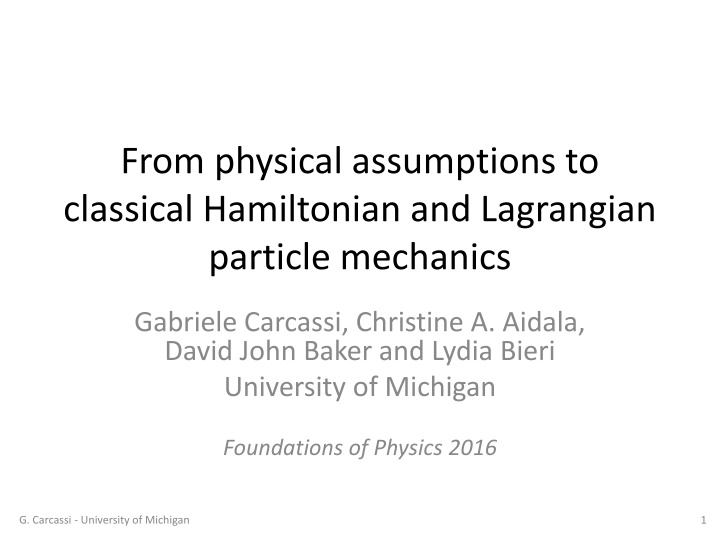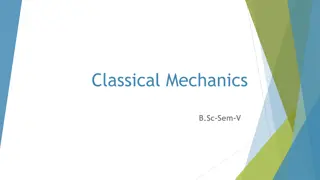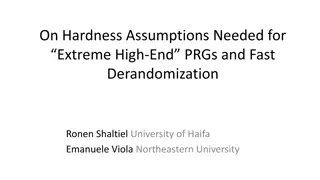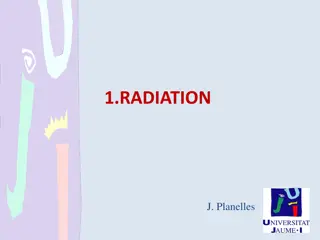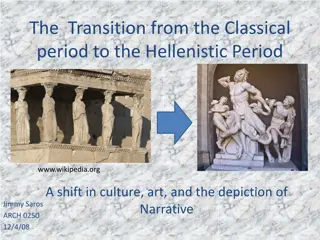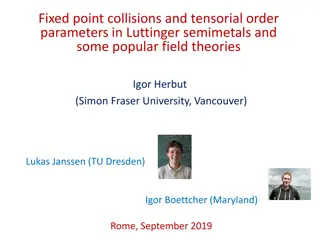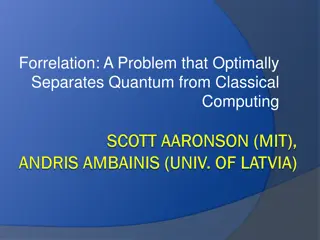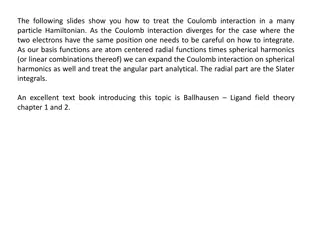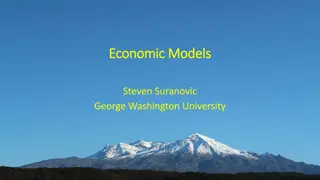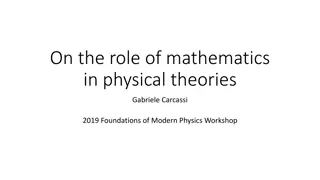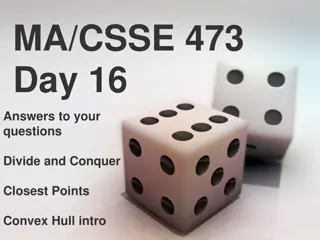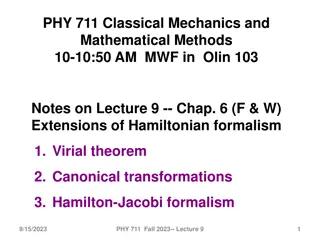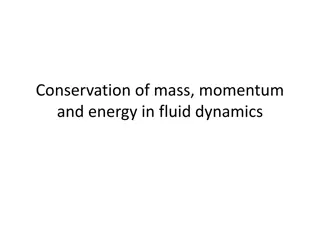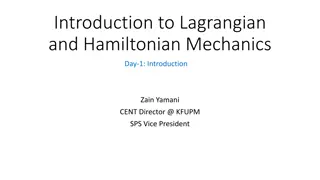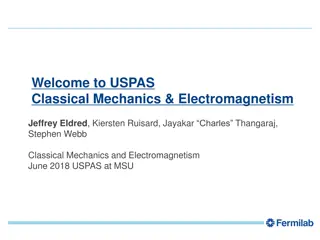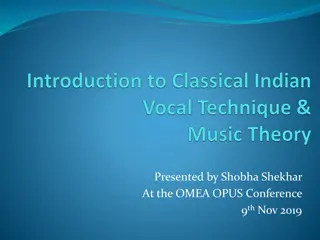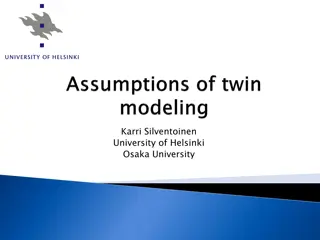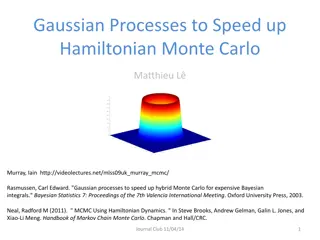Physical Assumptions to Classical Hamiltonian
Delve into the foundations of classical Hamiltonian and Lagrangian particle mechanics by starting from physical assumptions. Gain insights into how these assumptions lead to the known mathematical frameworks, providing a bridge between physics and mathematics. Explore the motivation behind Hamiltonian and Lagrangian mechanics and their relation to the system under study. Discover the importance of determinism and reversibility in understanding classical systems.
Download Presentation

Please find below an Image/Link to download the presentation.
The content on the website is provided AS IS for your information and personal use only. It may not be sold, licensed, or shared on other websites without obtaining consent from the author.If you encounter any issues during the download, it is possible that the publisher has removed the file from their server.
You are allowed to download the files provided on this website for personal or commercial use, subject to the condition that they are used lawfully. All files are the property of their respective owners.
The content on the website is provided AS IS for your information and personal use only. It may not be sold, licensed, or shared on other websites without obtaining consent from the author.
E N D
Presentation Transcript
From physical assumptions to classical Hamiltonian and Lagrangian particle mechanics Gabriele Carcassi, Christine A. Aidala, David John Baker and Lydia Bieri University of Michigan Foundations of Physics 2016 G. Carcassi - University of Michigan 1
Introduction The purpose of this talk is to answer a (seemingly) simple type of question: what are Hamiltonian systems? Or Lagrangian? Or classical (vs quantum)? Not all systems are Hamiltonian (or Lagrangian, or classical, or quantum) If I have a system in front of me, how can I tell whether it s a Hamiltonian system? When is the state space ? ?? Or a complex vector space? The problem is that Hamiltonian/Lagrangian classical/quantum mechanics start by setting the mathematical framework Unlike Newtonian mechanics, thermodynamics and special relativity that start from physical laws or postulates We are left with the mathematical definition: a Hamiltonian system is one described by Hamiltonian framework Many appear to be satisfied by this answer To me, it begs the question G. Carcassi - University of Michigan 2
Introduction To answer the question, we need a way to physically motivate Hamiltonian (and Lagrangian) mechanics Start from physical assumptions that characterize the system under study Hopefully ideas that are already familiar Show that those assumptions lead necessarily to the known mathematical frameworks in the most direct way possible not to some new theory Gain new insights provide a math-physics dictionary The objective of this talk is to show that such a program is indeed possible and worthwhile G. Carcassi - University of Michigan 3
Introduction We limit ourselves here to classical Hamiltonian/Lagrangian particle mechanics no relativity, quantum or field theory Go through highlights of the derivation and give physical intuition for them Elements from different fields are used: vector spaces, topology, measure theory, differential/ symplectic/Riemannian geometry Let s start with an overview of the assumptions and what they lead to The rest of the talk is more details and insight to see how it all works G. Carcassi - University of Michigan 4
Overview Only 3 assumptions: Determinism and reversibility (given the initial state we can identify the final state and vice versa) Dynamical system State space is a topological space, evolution map is a self- homeomorphism Infinitesimal reducibility (describing the state of the whole is equivalent to describing the state of its infinitesimal parts) Hamiltonian mechanics for infinitesimal parts State of the whole is a distribution over the state space for the infinitesimal parts (i.e. phase space) Kinematic equivalence (studying the motion of the infinitesimal parts is equivalent to studying the state evolution) Lagrangian mechanics for infinitesimal parts Dynamics is the one for massive particles under scalar/vector potential forces G. Carcassi - University of Michigan 5
Assumption I: Determinism and reversibility The system undergoes deterministic and reversible time evolution: given the initial state, we can identify the final state; given the final state, we can reconstruct the initial state G. Carcassi - University of Michigan 6
Physical distinguishability and topological spaces States are physical configurations of the system at a given time => states must be physically distinguishable There must exist an external process (i.e. that involves the environment) that is potentially able to tell two states apart How do we mathematically capture physical distinguishability? G. Carcassi - University of Michigan 7
Physical distinguishability and topological spaces System under study (identically prepared n times) External process Set of states Set of outcomes Set of states compatible with the given outcome The collection of all sets of states compatible with all potential outcomes of all potential processes form a Hausdorff and second countable topology G. Carcassi - University of Michigan 8
Physical distinguishability and topological spaces Use of sets and set operations is apparent in exclusion plots Range of WIMP (dark matter) mass/cross section excluded by different experiments Range of Higgs masses excluded by different experiments G. Carcassi - University of Michigan 9
Mapping physical objects and continuous functions Physical distinguishability -> topological space We now want to associate initial and final states through the evolution map The map has to be compatible with physical distinguishability: distinguishing final (or initial) states is also distinguishing initial (or final states) How do we mathematically capture maps between physically distinguishable objects? If ? is a distinguishable set of final states, then ? 1(?) is a distinguishable set of initial states: ? 1(?) is in the topology A map between distinguishable objects is a continuous map by definition G. Carcassi - University of Michigan 10
Mapping physical objects and continuous functions Continuous functions are fundamental in physics as they preserve what constitutes a set of states that can be associated to the outcome of a physical process. Standard topology for ? excludes infinite precision knowledge of one continuous quantity (sets with one point) and implies topological continuity <=> analytical continuity Finite precision knowledge of one continuous quantity corresponds to finite precision knowledge of the other Finite precision knowledge of one continuous quantity does not always correspond to finite precision knowledge of the other G. Carcassi - University of Michigan 11
Deterministic and reversible maps and homeomorphisms Physical distinguishability -> topological space Map between physically distinguishable objects -> continuous map Deterministic and reversible evolution is a bijective map A bijective continuous map is a homeomorphism: deterministic and reversible evolution is a self- homeomorphism A map onto the same space that preserves what is physically distinguishable (i.e. the topology) G. Carcassi - University of Michigan 12
Not all self-homeomorphisms are deterministic and reversible maps Discrete topology Standard (continuous) topology Map is a self-homeomorphism ?:? ? Map is a self-homeomorphism ?:? ? ? Cardinality of states is conserved # ? = # ? ? ? Independent variables remain independent ?:?1 ?2 ? # ? ?,? = # ? # ? = # ? ? # ? ? A self-homeomorphism that maps a set to a proper superset or subset is clearly not a deterministic or reversible process! Need to keep track of the cardinality of states and possibilities. We need a measure. G. Carcassi - University of Michigan 13
From assumption I Physical distinguishability -> topological space Map between physically distinguishable objects -> continuous map Deterministic and reversible evolution -> self- homeomorphism Not all self-homeomorphisms -> need a measure to count states G. Carcassi - University of Michigan 14
Assumption II: infinitesimal reducibility (classical material) The system is composed of a homogeneous infinitesimally reducible material. Each part undergoes deterministic and reversible evolution. G. Carcassi - University of Michigan 15
Classical homogeneous material and real vector spaces A classical material is: Decomposable: can be divided into smaller amounts Infinitesimally so: can keep dividing arbitrarily ( particles are the limits of such division) Reducible: giving state of whole equivalent to giving state of parts Homogeneous: state space of each part is the same A classical fluid is an example How do we mathematically capture the structure of such material? G. Carcassi - University of Michigan 16
Classical homogeneous material and real vector spaces Homogeneous and decomposable => law of composition +:? ? ? = + Infinitesimally decomposable => increase/decrease the amount of material by a real number 2 = These two operations give the structure of a vector space G. Carcassi - University of Michigan 17
Classical homogeneous material and function spaces Infinitesimally reducible homogeneous material -> real vector space We want to characterize the material in terms of the state of each particle, the infinitesimal part that is the limit of the process of recursive subdivision Let ? be the state space for particles. What can we tell about ? the state space for the composite system? For each composite state ? ? we have a distribution ??:? that tells us the amount of material (or density) for that particle state The function is continuous as particle states and amounts of material are physically distinguishable The state space ? is isomorphic as a real vector space to a subspace of the real valued continuous functions over ?, the state space for particles: ? ? ?(?) G. Carcassi - University of Michigan 18
Integration and measure Infinitesimally reducible homogeneous material -> real vector space Composite state -> continuous distributions over particle state space In practice, we want amounts of material for a set ? ? of the particle states We don t measure the density of a fluid at a specific position and momentum We measure how much material is in this volume with this momentum range How do we mathematically capture the relationship between the distribution ??and the amount of material found in ? ?? Given a region ? ? we have a functional that given a distribution returns the amount of material: ?:?(?) By Riesz representation theorem, exists unique Borel (i.e. compatible with the topology) measure ? such that ??? = ????? A way to count states! Only measure finite amounts of material: the distributions are integrable Particle state space ? is a measure space. Composite state space ? is isomorphic to subspace of Lebesgue integrable functions: ? ? ?1? G. Carcassi - University of Michigan 19
Integration and measure Because we have densities and integration we can assign a measure (a size ) to each set of states Take a set of particle states. Fill it with a uniform density. Look at the total amount of material. ? Zero amount: zero measure set Zero amount: zero measure set ? Analogous to using water to measure the capacity of a container G. Carcassi - University of Michigan 20
Invariant densities and differentiability Finite amounts of material -> Measure and integrability For discrete states, ??? = ??(?) with ? a discrete state variable For continuous states, expect ??? = ??? ?? with ? a continuous state variable ??? ??? the density This does not work! Changing variables ????= ???? changes: densities in general are a function of coordinates Our distributions are a function of the state??? : they are invariant densities We need to make sure we can have invariant densities Jacobian must be well defined => differentiability ? is a differentiable manifold ? isomorphic to the space of integrable differentiable functions: ? ?1? ?1? Note: ?1? ?1? is not a complete metric space G. Carcassi - University of Michigan 21
Invariant densities and symplectic manifolds Finite amounts of material -> Measure and integrability Invariant distributions -> Differentiability Jacobian must be unitary Changing physical units should not change our distribution Let ? be the manifold that defines the system of units, invariant densities are defined on T ? Canonical two-form ? = ??? ???= ??? ??? allows counting the number of possibilities defined on each independent d.o.f. ? is a symplectic manifold formed by T ? and the symplectic form ? G. Carcassi - University of Michigan 22
Invariant densities and symplectic manifolds 1 0 0 0 1 0 0 0 1 0 ?? 0 0 1 0 ? = ??? ???= ??? ??? ???= = ?? 1 Scalar product across independent d.o.f. Wedge product (area) within a d.o.f. Number of states = ?? ?? => independent d.o.f are orthogonal => sum of projections ? = 1 ? 1 1 ? = 1 ? ? = 100 ??/? ? ? = 0.01 ?? 1 1 ?2 ?2 ? = 100 ?? ?1 ?1 Number of possibilities = ? ? is invariant G. Carcassi - University of Michigan 23
Deterministic and reversible maps and symplectomorphisms Invariant distributions -> Differentiability; symplectic (metric) space ? ?,? Now characterize deterministic and reversible evolution Each particle state mapped to one and only one particle state, density values transported to new states, cardinality of possibilities and states preserved Deterministic and reversible time evolution is a symplectomorphism (an isometry): metric ? is preserved Infinitesimal symplectomorphism admits potential ? such that ????= ???? ????= ???? Deterministic and reversible time evolution for a particle of classical material follows Hamilton s equations G. Carcassi - University of Michigan 24
Deterministic and reversible maps and symplectomorphisms Possibilities (area) within a d.o.f. conserved (??,??) ( ??, ??) (??,??) Independent d.o.f. remain independent (orthogonal) ( ??, ??) Total number of states (volume) is conserved All that Hamiltonian mechanics does is to conserve the number of states and possibilities It s the continuous equivalent of 3 possibilities for x times 2 possibilities for y gives 6 total states G. Carcassi - University of Michigan 25
From assumption II Infinitesimally reducible homogeneous material -> real vector space Composite state -> continuous distributions over particle state space Finite amounts of material -> Measure and integrability Invariant distributions -> Differentiability; symplectic (metric) space ? ?,? Deterministic and reversible map -> symplectomorphism (isometry) and Hamilton s equations G. Carcassi - University of Michigan 26
Assumption III: kinematic equivalence Studying the motion (kinematics) of the system is equivalent to studying its state evolution (dynamics) G. Carcassi - University of Michigan 27
Kinematic equivalence and Lagrangian systems Each particle has no relevant internal dynamics: motion tells us everything Falling rock has no relevant internal dynamics A helicopter has relevant internal dynamics How do we capture mathematically a system where kinematic equivalence applies? One-to-one relationship (homeomorphism) between state variables ?,? and initial conditions ?, ? . State will be identified by only position and velocity Set ??= ??. We have ??= ????,?? = ????= ????. ?? is invertible, monotonic in ??. ? is convex, admits a Lagrangian A Hamiltonian system where kinematic equivalence applies is a Lagrangian system G. Carcassi - University of Michigan 28
Kinematic equivalence, inertial mass and conservative forces Can convert between state variables and initial conditions - > Convex Hamiltonian; existence of Lagrangian Distribution must be expressible in terms of initial conditions Use initial conditions to count states. ? must be proportional to an invariant bilinear function: ? = ??? ??? ?(???,? ??) ??? ???= ??????????= ???????. ???= ????. ??= ???+ ??(??) ???? = ????= ?? ? = The Hamiltonian limited to particle under scalar and vector potential forces 1 2??? ??????? ?? + ?(??) G. Carcassi - University of Michigan 29
Kinematic equivalence, inertial mass and conservative forces What is inertial mass? It s the constant that tells us how many possibilities (i.e. possible states) there are for a unit range of velocity. More massive object = more states ?0 ?1 Why is a more massive body more difficult to accelerate? Because for the same change in velocity it has to go through more states. What are conservative forces? The ones that conserve the number of states (deterministic and reversible forces). G. Carcassi - University of Michigan 30
From assumption III Can convert between state variables and initial conditions -> Convex Hamiltonian; existence of Lagrangian Invariant densities on initial conditions -> linear relationship between conjugate momentum and velocity; inertial mass; scalar/vector potential forces G. Carcassi - University of Michigan 31
Conclusion Physically motivating Hamiltonian and Lagrangian mechanics is possible and offers insights Classical Hamiltonian and Lagrangian mechanics founded upon three physical assumptions, which give the definition of states and their laws of evolution Only distributions give meaningful account for use of cotangent bundle/Hamilton s equations Kinematic equivalence gives potential forces, tells why second order equations of motion, what is inertial mass Extending this approach to other fundamental theories may give insights useful to address open problems G. Carcassi - University of Michigan 32
